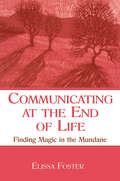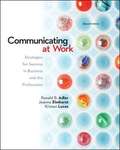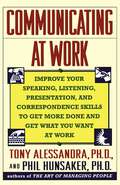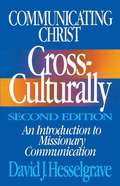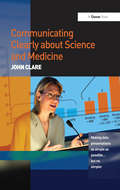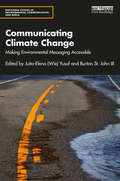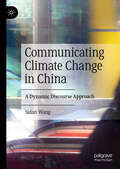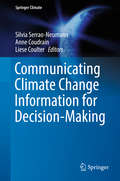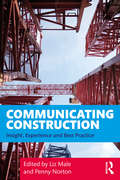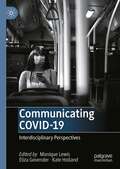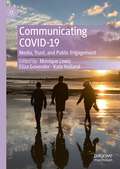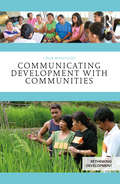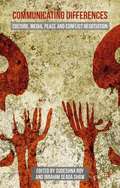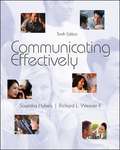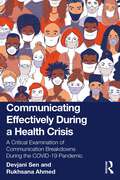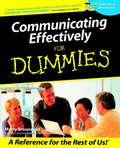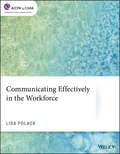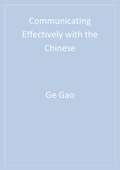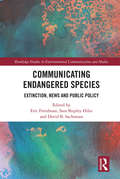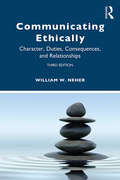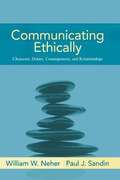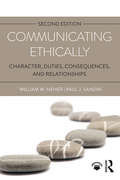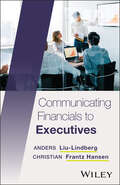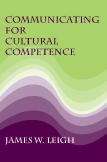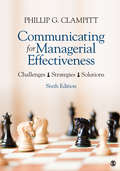- Table View
- List View
Communicating at the End of Life: Finding Magic in the Mundane (LEA's Series on Personal Relationships)
by Elissa FosterThis enlightening volume provides first-hand perspectives and ethnographic research on communication at the end of life, a topic that has gone largely understudied in communication literature. Author Elissa Foster’s own experiences as a volunteer hospice caregiver form the basis of the book. Communicating at the End of Life recounts the stories of Foster and six other volunteers and their communicative experiences with dying patients, using communication theory and research findings to identify insights on the relationships they form throughout the process. What unfolds is a scholarly examination of a subject that is significant to every individual at some point in the life process. Organized chronologically to follow the course of Foster’s involvement with hospice and the phases of the study, the book opens with Part 1, providing background and contextual information to help readers understand subsequent stories about communication between volunteers and patients. Part 2 of the volume emphasizes the adjustments required by the volunteers as they entered the world of hospice and the worlds of the patients. Part 3 underscores the importance of improvisation and finding balance within the role of volunteer—in particular how to be fully present for patients as well as their family members. The volume concludes with Part 4, which addresses how volunteers coped with the death of their patients and what they learned from the experience of volunteering. Communicating at the End of Life is appropriate for scholars and advanced students studying personal relationships, health communication, gerontology, interpersonal communication, lifespan communication, and communication & aging. Its unique content offers precious and meaningful insights on the communication processes at a critical point in the life process.
Communicating at Work: Strategies For Success in Business and the Professions (11th Edition)
by Ronald B. Adler Jeanne Marquardt Elmhorst Kristen LucasThe 11th edition of Communicating at Work enhances the strategic approach, real-world practicality, and reader-friendly voice that have made this text the market leader for three decades. On every page, students learn how to communicate in ways that enhance their own career success and help their organization operate effectively. This edition retains the hallmark features that have been praised by faculty and students--a strong emphasis on ethical communication and cultural diversity, discussions of evolving communication technologies, and self-assessment tools--while incorporating important updates and ground-breaking digital teaching and learning tools to help students better connect to the course material and apply it to real world business situations.
Communicating at Work
by Tony AlessandraIn today's competitive workplace, your ability to communicate is your most important business skill.This valuable handbook to better business communication can help you develop the skills you need to succeed. Using real-life examples, it offers practical, easy-to-use instruction in writing effective memos and reports, making memorable presentations, and leading productive meetings. It also introduces key telephone skills, shows you how to interpret body language and personal communication styles -- and teaches you the critical listening and questioning skills you need to get ahead.Whether you're a top manager trying to lead a large organization or one of the millions of people who actually get the work done, Communicating at Work can help you be more effective, get more of what you want out of work, and improve your chances for success.
Communicating Christ Cross-Culturally: An Introduction to Missionary Communication
by David HesselgraveThis revised edition of Dr. David Hesselgrave's great work Communicating Christ Cross-Culturally updates the original edition and interacts with the most recent literature on this increasingly important topic. The original edition went through fifteen printings and, very deservedly, has come to be one of the most widely used textbooks on Christian cross-cultural communications. The revisions in this new edition are extensive and carry on the high level of discussion maintained throughout the original edition, taking into account, for example, the current discussion on the relationship between form and function and the enormous body of literature that has sprung up recently on contextualization. To enhance the volume's usefulness for students, Dr. Hesselgrave has added an extensive bibliography of twenty-five pages on various aspects of cross-cultural communications. This revision of Communicating Christ Cross-Culturally is superb. It raises a great book into a unique category, undoubtedly the finest book on this topic available today.
Communicating Clearly about Science and Medicine: Making Data Presentations as Simple as Possible ... But No Simpler
by John ClareScientific communication is challenging. The subject matter is complex and often requires a certain level of knowledge to understand it correctly; describing hazard ratios, interpreting Kaplan Meier curves and explaining confounding factors is different from talking about a new car or clothing range. Processes, for example in clinical trials, are laborious and tedious and knowing how much of the detail to include and exclude requires judgement. Conclusions are rarely clear cut making communicating statistical risk and probability tough, especially to non-statisticians and non-scientists such as journalists. Communicating Clearly about Science and Medicine looks at these and many more challenges, then introduces powerful techniques for overcoming them. It will help you develop and deliver impactful presentations on medical and scientific data and tell a clear, compelling story based on your research findings. It will show you how to develop clear messages and themes, while adhering to the advice attributed to Einstein: 'Make things as simple as possible...but no simpler.' John Clare illustrates how to communicate clearly the risks and benefits contained in a complex data set, and balance the hope and the hype. He explains how to avoid the 'miracle cure' or 'killer drug' headlines which are so common and teaches you how to combine the accuracy of peer-to-peer reviewed science with the narrative skills of journalism.
Communicating Climate Change: Making Environmental Messaging Accessible (Routledge Studies in Environmental Communication and Media)
by Juita-Elena Wie Yusuf And Burton St. John IIIThis edited collection focuses on theoretical and applied research-based observations concerning how experts, advocates, and institutions make climate change information accessible to different audiences. Communicating Climate Change concentrates on three key elements of climate change communication – access, relevance, and understandability – to provide an overview of how these aspects allow multiple groups of stakeholders to act on climate-related information to build resilience. Featuring contributions from a wide range of scholars from across different disciplines, this book explores a multitude of different scenarios and communication methods, including social media; public opinion surveys; participatory mapping; and video. Overall, climate change communication is addressed from three different perspectives: communicating with the public; communicating for stakeholder engagement; and organizational, institutional, risk, and disaster communication. With each chapter focusing on implications and applications for practice, this book will be of great interest to students and researchers of climate change and environmental communication, as well as practitioners interested in understanding how to better engage stakeholders through climate change-related communication.
Communicating Climate Change in China: A Dynamic Discourse Approach
by Sidan WangThis book explores how China's media narrate climate policy and climate change. With the rapid growth of economy and carbon emissions, China has been seen as having a key role in addressingclimate change and receives substantial attention from the media. In theChinese coverage, climate change issues can be interpreted as various concernsand ideas involving the dimensions of the economy, energy and emissions, publicinvolvement, science and ecology, and responsibility. In this sense, a discourseapproach can be used to understand how the newspapers construct the climatechange discourse and discourse networks in the coverage. This study selectsthree different newspapers in China, namely People’sDaily, China Daily and Southern Weekend. This book will interest scholars of Chinese politics, environmentalists, and media studies scholars.
Communicating Climate Change Information for Decision-Making (Springer Climate)
by Liese Coulter Anne Coudrain Silvia Serrao-NeumannThis book provides important insight on a range of issues focused on three themes; what new climate change information is being developed, how that knowledge is communicated and how it can be usefully applied across international, regional and local scales. There is increasing international investment and interest to develop and communicate updated climate change information to promote effective action. As change accelerates and planetary boundaries are crossed this information becomes particularly relevant to guide decisions and support both proactive adaptation and mitigation strategies. Developing new information addresses innovations in producing interdisciplinary climate change knowledge and overcoming issues of data quality, access and availability. This book examines effective information systems to guide decision-making for immediate and future action. Cases studies in developed and developing countries illustrate how climate change information promotes immediate and future actions across a range of sectors.
Communicating Construction: Insight, Experience and Best Practice
by Liz Male and Penny NortonThis book is a wide-ranging exploration of PR and communication in the construction industry, with a strong emphasis on communications theory, strategy and technique. The editors begin with an introduction to the UK construction industry and its supply chains, as well as various elements of PR in relation to the construction process. Subsequent chapters provide a strategic overview, practical examples, success stories, case studies and personal perspectives on PR for different parts of the built environment and reputational issues in construction. Chapters include expert advice on communications for architecture, planning, building consultancy, building products and manufacturers, general and specialist contractors, construction technology, infrastructure and communicating sustainability in the built environment. The conclusion looks at the current and upcoming reputational priorities for communicators in construction, as well as the top ten priorities for implementing PR as a strategic management discipline in the industry. This book is essential reading for all construction PR teams, students studying both for built environment and PR/marketing degrees and CPD courses, and anyone working in the built environment sector who needs to consider PR and marketing as part of their role.
Communicating COVID-19: Interdisciplinary Perspectives
by Kate Holland Monique Lewis Eliza GovenderThis book explores communication during the first year of the COVID-19 pandemic. Featuring the work of leading communication scholars from around the world, it offers insights and analyses into how individuals, organisations, communities, and nations have grappled with understanding and responding to the pandemic that has rocked the world. The book examines the role of journalists and news media in constructing meanings about the pandemic, with chapters focusing on public interest journalism, health workers and imagined audiences in COVID-19 news. It considers public health responses in different countries, with chapters examining community-driven approaches, communication strategies of governments and political leaders, public health advocacy, and pandemic inequalities. The role of digital media and technology is also unravelled, including social media sharing of misinformation and memetic humour, crowdsourcing initiatives, the use of data in modelling, tracking and tracing, and strategies for managing uncertainties created in a pandemic.
Communicating COVID-19: Media, Trust, and Public Engagement
by Monique Lewis Eliza Govender Kate HollandThis edited collection, follows on from 'Communicating COVID-19: Interdisciplinary Perspectives' (2021) and brings together different scholars from around the world to explore and critique the ongoing advances of communicating COVID, two years into the pandemic. Pandemic life has become familiar to us, with all its disruptions and uncertainties. In the second year of COVID, many societies emerged well attuned to new waves of infections, while others, having initially demonstrated 'gold standard' responses, regressed, either through a premature end to public health restrictions or challenges around vaccine rollouts. In many countries, bitter social divisions have arisen over mask-wearing, lockdowns, quarantine and vaccination. To better understand the ever evolving communicative landscape of COVID-19, this collection shares updated perspectives from the disciplines of media and communication, journalism, public health and primary care, sociology, and political and behavioural science, addressing the major issues that have confronted communicators, including vaccine hesitancy, misinformation, and the mobilisation of community driven communication responses as restrictions eased in various parts of the world.
Communicating Development with Communities (Rethinking Development)
by Linje ManyozoDevelopment theory and practice are often taught in a manner that strips them of their historical context and obscures alternative intellectual assumptions and critical frameworks. This prevents students from acquiring a holistic understanding of the world and consequently, when it comes to development practice, most lack the skills to live and engage with people. It has become crucial to properly consider what it means to conceive and implement participatory development out in the field and not just in the boardroom. Building on the work of Robert Chambers and Arturo Escobar, Communicating Development with Communities is an empirically grounded critical reflection on how the development industry defines, imagines and constructs development at the implementation level. Unpacking the dominant syntax in the theory and practice of development, the book advocates a move towards relational and indigenous models of living that celebrate local ontologies, spirituality, economies of solidarity and community-ness. It investigates how subaltern voices are produced and appropriated, and how well-meaning experts can easily become oppressors. The book propounds a pedagogy of listening as a pathway that offers a space for interest groups to collaboratively curate meaningful development with and alongside communities. This is a valuable resource for academics and practitioners in the fields of Development Studies, Communication for Development, Communication for Social Change, Social Anthropology, Economic Development and Public Policy. Foreword by Robin Mansell.
Communicating Differences: Culture, Media, Peace and Conflict Negotiation
by Ibrahim Shaw Sudeshna RoyThis volume captures the essence of how we communicate differences in relationships, between and across cultures, in organizations, through education and in moments of local and global conflict and crisis that demonstrates the importance and viability of approaching peace and conflict communication from various fields within communication studies.
Communicating Effectively (10th Edition)
by Saundra Hybels Richard L. Weaver IICommunicating Effectively, Tenth Edition, presents the foundations of communication theory and provides many opportunities for skill building practice. Using a pragmatic approach with numerous examples from the classroom, workplace, and community, students will learn to appreciate the practical application of the ideas, concepts, and theories in their own lives and in the lives of people close to them.
Communicating Effectively During a Health Crisis: A Critical Examination of Communication Breakdowns During the COVID-19 Pandemic
by Rukhsana Ahmed Devjani SenExploring how and why communication breakdowns occur during pandemics and world disasters, this book offers solutions for improving communication and managing future public health crises.A compilation of evidence-based lessons learned, this book shows how to effectively convey critical lifesaving information during a pandemic. It assesses how trust in leaders and governments during a public health crisis is formed and the impact this has on how information is perceived by the public. Using the COVID-19 pandemic as a case study, the book demonstrates how informative policy decisions and health risk messages can be better communicated for the handling of future pandemics. At a macro-level, the book looks at issues concerning situational awareness, how different countries managed or mismanaged the pandemic, and the lessons readers can learn from those occurrences. At a micro-level, it examines individual differences in public health message perceptions and corresponding actions taken or not taken.An interdisciplinary critique of the delivery and reception of messages during global disasters, this text is suitable for undergraduate and graduate courses in Communication Studies, Health Communication, Risk Communication and Public Health, Psychology, Sociology, and Disaster Management.
Communicating Effectively For Dummies (For Dummies Ser.)
by Marty BrounsteinCommunicating Effectively For Dummies shows you how to get your point across at work and interact most productively with bosses and coworkers. Applying your knowledge and skill to your job is the easy part; working well with others is often the hard part. This helpful guide lets you maximize your personal interactions, even when resolving conflicts, dealing with customers, or giving difficult presentations. Whether you’re the CEO of a major corporation, a small business owner, or a team manager, effective and clear communication is imperative to your success. From keeping your listener engaged to learning to become a better listener, Communicating Effectively For Dummies offers all the strategies, tips, and advice you need to: Learn how to become an active listener Accentuate the positive in negative situations Find win-win solutions for conflicts Stay on track when writing e-mails and letters Handle presentations, interviews, and other challenges Speak forcefully and assertively without alienating others Management consultant Marty Brounstein — author of Handling the Difficult Employee and Coaching and Mentoring For Dummies — gives you the keys to a thriving career with expert advice on effective verbal and nonverbal communication. From mastering your own facial expressions (and reading them in others) to being a happy boss, Brounstein covers all the angles: Becoming aware of your own assumptions Dealing with passive-aggressive communicators What to say to help someone open up to you Communicating through eye contact and body language Maintaining a positive attitude Dealing with sensitive issues Effective conflict resolution models When to use e-mail, the phone, or a face-to-face meeting Dealing with angry customers Coaching your staff to communicate better In today’s high-stress work environment, good communication skills are imperative for keeping your cool and getting your point across. Knowing what to say and how to say it, as well as being a good listener, can often be the difference between getting ahead and just getting by. This handy, friendly guide shows you how to avoid common conflicts and make your voice heard in the office.
Communicating Effectively in the Workforce (AICPA)
by Lisa PolackIf you do not understand how communication works, then you may become perplexed and frustrated by interactions in the workplace. However, if you understand how communication works, then you have a good chance of diagnosing and fixing communication problems. Best of all, you can influence and motivate your employees, make better decisions, negotiate more effectively, build better work teams, and accomplish business objectives. This book discusses the various forms of communication.
Communicating Effectively with the Chinese
by Ge Gao Dr Stella Ting-ToomeyUtilizing the `self-OTHER' perspective as a conceptual foundation, the authors portray and interpret some of the distinctive communication practices in Chinese culture. They examine how self-conception, role and hierarchy, relational dynamics and face affect ways of conducting everyday talk in Chinese culture. They explain why miscommunication between Chinese and North Americans takes place and suggest ways to improve communication. By incorporating instances of everyday talk, the authors offer a realistic and clear illustration of the specific characteristics and functions of Chinese communication, as well as problematic areas of Chinese//North American encounters.
Communicating Endangered Species: Extinction, News and Public Policy (Routledge Studies in Environmental Communication and Media)
by Eric Freedman; Sara Shipley Hiles; David B. SachsmanCommunicating Endangered Species: Extinction, News, and Public Policy is a multidisciplinary environmental communication book that takes a distinctive approach by connecting how media and culture depict and explain endangered species with how policymakers and natural resource managers can or do respond to these challenges in practical terms. Extinction isn’t new. However, the pace of extinction is accelerating globally. The International Union for Conservation of Nature classifies more than 26,000 species as threatened. The causes are many, including climate change, overdevelopment, human exploitation, disease, overhunting, habitat destruction, and predators. The willingness and the ability of ordinary people, governments, scientists, nongovernmental organizations, and businesses to slow this deeply disturbing acceleration are uncertain. Meanwhile, researchers around the world are laboring to better understand and communicate the possibility and implications of extinctions and to discover effective tools and public policies to combat the threats to species survival. This book presents a history of news coverage of endangered species around the world, examining how and why journalists and other communicators wrote what they did, how attitudes have changed, and why they have changed. It draws on the latest research by chapter authors who are a mix of social scientists, communication experts, and natural scientists. Each chapter includes a mass media and/or cultural aspect. This book will be essential reading for students, natural resource managers, government officials, environmental activists, and academics interested in conservation and biodiversity, environmental communication and journalism, and public policy.
Communicating Ethically: Character, Duties, Consequences, and Relationships
by William W. NeherThis thoroughly updated third edition of Communicating Ethically provides a broad introduction to the ethical nature of communication, bringing together classical and modern theories of ethical philosophy to address issues at play in specific careers and domains throughout the field. By incorporating a simple framework for ethical reasoning, the reader will be able to develop their own understanding of the various criteria for making ethical judgments. Communicating Ethically applies ethical theories such as virtue ethics and dialogic ethics to contexts of interpersonal, organizational, political, and digital communication. This edition contains expanded coverage of contemporary and non-Western theories and contexts, including Black Lives Matter, #MeToo, social media and "fake news," and concerns of inclusion and marginalization. Each chapter contains a Preview and Key Ideas sections, and the book contains a Glossary. This book serves as core textbook for undergraduate courses in communication and media ethics, and can also serve as a supplemental resource for field-specific courses in Strategic Communication, Interpersonal Communication, and Public Relations. Online resources for instructors include sample syllabi, sample assignments, and quiz questions. They are available at www.routledge.com/9780367358471.
Communicating Ethically
by Paul Sandin William NeherCommunication Ethics provides a broad introduction to the ethical nature of communication. The book combines coverage of the major systems of ethical reasoning with lots of applications, including case studies in each chapter, to investigate ethics within many fields in the discipline: rhetoric, interpersonal communication, organizational communication, political communication, and mass communication/media. By incorporating a simple framework for ethical reasoning, the reader will be able to develop their own understanding of the various criteria for making ethical judgments.
Communicating Ethically: Character, Duties, Consequences, and Relationships
by Paul Sandin William NeherCommunicating Ethically provides a broad introduction to the ethical nature of communication. Now in its second edition, the text has been revised to further address current issues, such as: evolving social media and digital platforms, growing cultural communication and discussion of diversity, and the ethics of public discourse. This book combines coverage of the major systems of ethical reasoning with applications, including case studies in each chapter, to investigate ethics within many fields in the communication discipline. Incorporating a simple framework for ethical reasoning allows the reader to develop their own understanding of the various criteria for making ethical judgments.
Communicating Financials to Executives
by Anders Liu-Lindberg Christian Frantz HansenPractical guide to effectively communicate financial data, ideas, and insights to executives Communicating Financials to Executives delivers indispensable insights on how to clearly, effectively and productively communicate financials to executives across industries in an influential manner. In this book, finance practitioners and consultants Anders Liu-Lindberg and Christian Frantz Hansen deliver a five-step approach on how to get started, along with underlying theory explaining why each step is imperative to success. Special attention is placed on not just presenting data but doing so in a way that brings significant value to the table and creates an impact that leads to greater business success for the organisation. Topics explored in this book include: The executive decision-making process and how to tailor your approach to seamlessly integrate into it Managing the amount of detail in communications and knowing how to structure data appropriately Visual elements that can help better communicate data to individuals who aren't “numbers people” Specific struggles that financial and accounting professionals face in the modern business environment How to build management reports that are easily understood by executives and drive significant business value Communicating Financials to Executives earns a well-deserved spot on the bookshelves of all finance professionals seeking to better harvest the fruits of their labour by properly articulating ideas and insights to decision-makers within an organisation.
Communicating for Cultural Competence
by James W. LeighExplains and demonstrates a model for social workers to communicate with persons of color by casting them in the role of experts on their own lives. Emphasis is placed on the beginning stage of the helping process, the information-gathering stage. What happens next is not addressed directly, although there is a lengthy appendix on culturally relevant treatment and interventions. Early chapters address information for achieving the role of a culturally competent social worker. Subsequent chapters outline steps of the interview model based on the ethnographic interviewing work of James Spradley. Includes chapter exercises and illustrations from interviews drawn from the author's practice and published cases. Appendices offer principles and codes of ethics. Annotation c. by Book News, Inc. , Portland, Or.
Communicating for Managerial Effectiveness: Challenges | Strategies | Solutions
by Phillip G. ClampittAppreciated by thousands of thoughtful students, successful managers, and aspiring senior leaders around the world Communicating for Managerial Effectiveness skillfully integrates theory, research, and real-world case studies into models designed to guide thoughtful responses to complex communication issues. The highly anticipated Sixth Edition builds on the strategic principles and related tactics highlighted in previous editions to show readers how to add value to their organizations by communicating more effectively. Author Phillip G. Clampitt (Blair Endowed Chair of Communication at the University of Wisconsin–Green Bay) addresses common communication problems experienced in organizations, including: Communicating about major changes spanning organizational boundaries Selecting the proper communication technologies Transforming data into knowledge Addressing ethical dilemmas Providing useful performance feedback Structuring and using robust decision-making practices Cultivating the innovative spirit Building a world-class communication system
